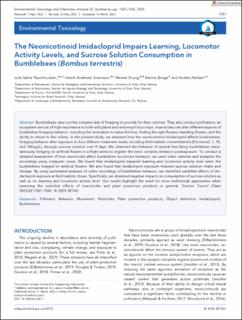| dc.contributor.author | Paus-Knudsen, Julie Sørlie | |
| dc.contributor.author | Sveinsson, Henrik Andersen | |
| dc.contributor.author | Grung, Merete | |
| dc.contributor.author | Borgå, Katrine | |
| dc.contributor.author | Nielsen, Anders | |
| dc.date.accessioned | 2023-10-04T12:26:16Z | |
| dc.date.available | 2023-10-04T12:26:16Z | |
| dc.date.created | 2023-05-04T12:33:20Z | |
| dc.date.issued | 2023-03-20 | |
| dc.identifier.citation | Environmental Toxicology and Chemistry. 2023, 42 (6), 1337-1345. | en_US |
| dc.identifier.issn | 0730-7268 | |
| dc.identifier.uri | https://hdl.handle.net/11250/3094149 | |
| dc.description.abstract | Bumblebees carry out the complex task of foraging to provide for their colonies. They also conduct pollination, an ecosystem service of high importance to both wild plants and entomophilous crops. Insecticides can alter different aspects of bumblebee foraging behavior, including the motivation to leave the hive, finding the right flowers, handling flowers, and the ability to return to the colony. In the present study, we assessed how the neonicotinoid imidacloprid affects bumblebees' foraging behavior after exposure to four different treatment levels, including field-realistic concentrations (0 [control], 1, 10, and 100 μg/L), through sucrose solution over 9 days. We observed the behavior of several free-flying bumblebees simultaneously foraging on artificial flowers in a flight arena to register the bees' complex behavior postexposure. To conduct a detailed assessment of how insecticides affect bumblebee locomotor behavior, we used video cameras and analyzed the recordings using computer vision. We found that imidacloprid impaired learning and locomotor activity level when the bumblebees foraged on artificial flowers. We also found that imidacloprid exposure reduced sucrose solution intake and storage. By using automated analyses of video recordings of bumblebee behavior, we identified sublethal effects of imidacloprid exposure at field-realistic doses. Specifically, we observed negative impacts on consumption of sucrose solution as well as on learning and locomotor activity level. Our results highlight the need for more multimodal approaches when assessing the sublethal effects of insecticides and plant protection products in general. | en_US |
| dc.language.iso | eng | en_US |
| dc.publisher | John Wiley & Sons Ltd. | en_US |
| dc.rights | Navngivelse-Ikkekommersiell 4.0 Internasjonal | * |
| dc.rights.uri | http://creativecommons.org/licenses/by-nc/4.0/deed.no | * |
| dc.title | The Neonicotinoid Imidacloprid Impairs Learning, Locomotor Activity Levels, and Sucrose Solution Consumption in Bumblebees (Bombus terrestris) | en_US |
| dc.title.alternative | The Neonicotinoid Imidacloprid Impairs Learning, Locomotor Activity Levels, and Sucrose Solution Consumption in Bumblebees (Bombus terrestris) | en_US |
| dc.type | Peer reviewed | en_US |
| dc.type | Journal article | en_US |
| dc.description.version | publishedVersion | en_US |
| dc.rights.holder | © 2023 SETAC | en_US |
| dc.source.pagenumber | 1337-1345 | en_US |
| dc.source.volume | 42 | en_US |
| dc.source.journal | Environmental Toxicology and Chemistry | en_US |
| dc.source.issue | 6 | en_US |
| dc.identifier.doi | 10.1002/etc.5611 | |
| dc.identifier.cristin | 2145444 | |
| dc.relation.project | Norges forskningsråd: 268415 | en_US |
| cristin.ispublished | true | |
| cristin.fulltext | original | |
| cristin.qualitycode | 2 | |

